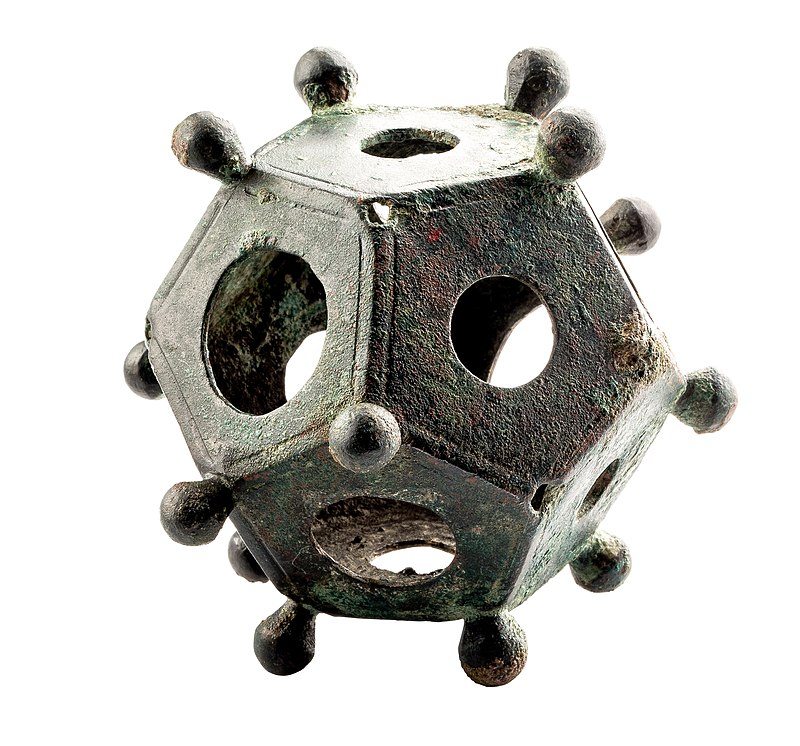The Roman dodecahedron remains one of the most perplexing archaeological finds to date. Dating back to the 2nd or 3rd century AD, these small, hollow objects made of bronze or stone have been unearthed across various regions once ruled by the Roman Empire. Characterized by their twelve flat pentagonal faces, each featuring a circular hole of varying diameter, these dodecahedrons have baffled historians and archaeologists for years.
With no written records of their purpose or use, a multitude of theories have emerged, ranging from religious artifacts to astronomical instruments. This article delves into the enigma of the Roman dodecahedron, examining the prevailing theories and the ongoing quest to uncover the true purpose of these mysterious objects.
What is the Dodecahedron?

The Roman Dodecahedron is typically made from bronze or stone and is often characterized by twelve flat pentagonal faces, each with a hole of varying diameter. Found across various sites in Europe, particularly in regions once under Roman rule, the dodecahedrons date from the 2nd to 4th centuries AD. Despite numerous instances of their discovery, their original purpose remains a topic of debate and speculation.
One of the most popular theories suggests that the dodecahedron was used as a measuring device, possibly for gauging distances or as a surveying tool. The different sizes of the holes in each pentagonal face might have been used for precision sighting or calibrating distances, though no concrete evidence supports this theory. Another hypothesis posits that these objects had a religious or ceremonial purpose, serving as a symbol or tool in ancient rituals, perhaps even related to the worship of the sky or the stars.
An interesting and more recent theory proposes that the dodecahedron was a handheld tool for knitting, used to form consistent-sized loops in wool and other fibers. This theory is supported by the practical application of the object’s design but, like other theories, lacks definitive proof. Additionally, some suggest that these artifacts were purely decorative, serving as a kind of art or status symbol among the Romans.
Despite these various hypotheses, the true purpose of the Roman dodecahedron remains shrouded in mystery. Their widespread discovery and consistent design indicate a common use, but without direct evidence or historical records, their original function continues to elude experts.
The Discovery of the Roman Dodecahedron
The discovery of the Roman dodecahedron has been a gradual and widespread phenomenon, with these intriguing artifacts surfacing in various parts of Europe. The first recorded discovery of a dodecahedron dates back to the 18th century, but it wasn’t until numerous similar objects were unearthed in different locations that intrigue and curiosity about them grew. Found in areas ranging from Wales to Hungary and from the north of Italy to the south of Germany, these objects have sparked interest due to their mysterious origins and unknown purpose.
Each dodecahedron has been found in varied contexts, ranging from Roman military sites and treasure troves to urban areas and rural settings. This wide range of discovery sites adds to the mystery, suggesting that their use was widespread across the Roman Empire but not limited to any specific social class or occupation. The dodecahedrons are typically small enough to fit in the palm of a hand, made of either bronze or stone and intricately crafted, with each of the twelve faces having a circular hole in the center of varying diameters.
Despite being a common find, the dodecahedrons are not mentioned in any known Roman texts or depicted in art, which further deepens the mystery. The lack of written records or depictions has led to much speculation among historians and archaeologists. Their discovery in such diverse locations implies a common and possibly significant purpose within the Roman Empire, yet the absence of any explanatory evidence makes their original use an ongoing subject of debate.
Conclusion
Despite numerous theories and extensive research, the true purpose of these objects continues to elude historians and archaeologists. Their widespread discovery across former Roman territories adds to the allure, suggesting a common use that was significant yet undocumented in historical records.
The mystery of the Roman dodecahedron encapsulates the challenges and excitement of unraveling the past. Each new find potentially edges us closer to understanding, yet for now, these objects stand as a fascinating reminder of the complexities and depths of ancient civilizations.